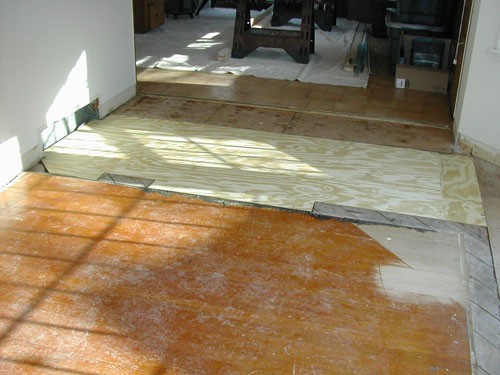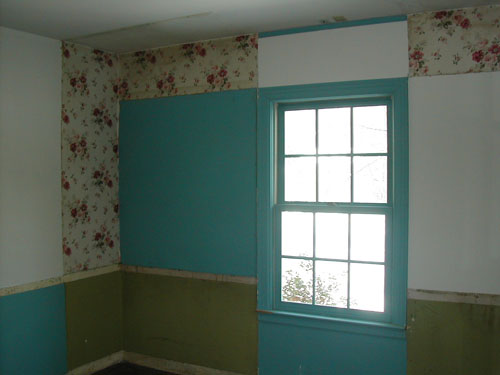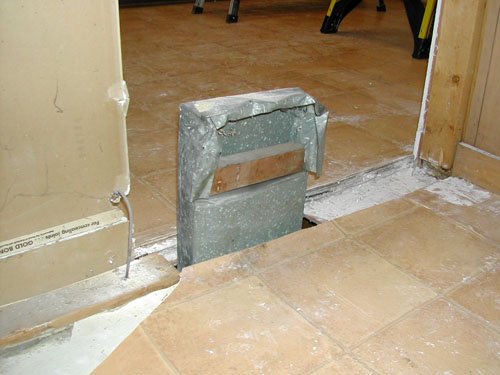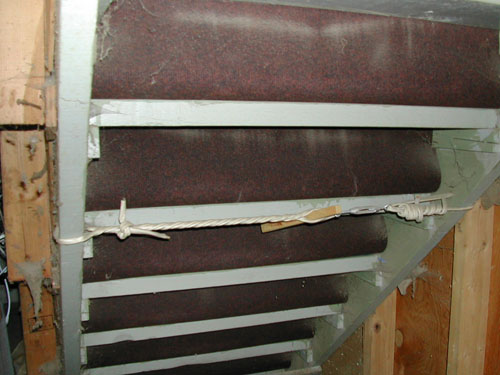
 by Steven D. Johnson
by Steven D. Johnson
Racine, Wisconsin
(Page 3 of 5)
Previous Page
1
2
3
4
5
Next Page
The Legacy of an Unhandy Guy
Every day so far with this new house has been an adventure. I dreamed of quickly ripping up the
carpet (I had already peeled up a corner and peeked) to reveal a gorgeous oak hardwood floor, ready
and waiting for a quick sanding and refinishing job.
Removing the carpet was way more difficult than I thought. The staples in the padding were
almost impossible to pull out. Then I discovered the staples from the previous installation of
padding that were never removed when the carpet was replaced. I lost count, and patience, but
ultimately got them all pulled. First to be prudent and frugal, I still have to wonder about a guy
that would patch together seventeen scraps of padding in a three-foot square space and use a
gazillion staples to hold it all down, when a bit larger piece of padding costs only a few bucks.
Oh well.
The hapless, helpless unhandyman that installed the carpet reused the existing tack strips. Most
must have come loose while he was removing the old carpet, because every tack strip had the original
nails and many, many more. Some were an inch long, some were longer. Some were ring shank nails,
some were finishing nails. Whatever was in the coffee can, that's what he used.
Halfway through the dining room, methodically cutting and ripping carpet, pulling staples, and
removing tack strips as I went, I discovered that the oak floors stopped, and there was plywood,
instead, under the carpet. It was not level and consisted of many patchwork pieces, plus it was
built up to approximately the same level as the hardwood floor, so it had to come out. Since the
hardwood floor and the plywood joint bisect the dining room, the only course of action is to install
new oak strips to complete the room.
I started prying plywood and praying that the pieces were layered on top of the original
subfloor. The first piece would not budge. I tried a smaller piece. After a quarter hour, it
started to move. I got one side up about a half-inch, banged it back down, and removed eleven nails
whose heads had been revealed. Still, the piece would not come up. Pry up, bang down, and remove
another ten nails. Still, it would not move. Pry up, bang down, and remove another six nails.
Finally, with the help of my largest crow bar and some very base animal sounds, I got the piece up.
It was sort of triangular shaped, maybe five square feet, total. There were a total of 82 nails in
that board. That's right...82. I counted 'em.
Finally, I got to the largest piece in this patchwork quilt of plywood. The screeching sound of
nails backing out of wood became musical in my ears. Millimeter by precious millimeter the board
started to come up. Soon I could get my hands under it. Crow bar on wood block for extra leverage,
more grunting sounds, and I heard the last of the nails start to give way. I started to lift.
Legs, back, all my strength. More nails released, but still the board was heavy...way heavier than
normal plywood. With one last mighty heave, the last of the nails gave up, and I got the plywood up
to a forty-five degree angle and peered underneath. With a sinking feeling, I realized why it felt
so heavy. On the underside were dozens of bits of lumber, scraps of plywood, roofing felt, a few
shingles, and even some folded newspaper (dated 1964, by the way) that the unhandyman had nailed to
the plywood to "shim" it level.

|
Figure 2: The "after" picture. Definitely a more
handy fix...a perfect fit, level and
tight, ready
for new oak flooring strips.
|
From a little "forensic" deconstruction, I have learned this much...The house was apparently
modified at least three times in its history. One of those modifications was an addition to the
back of the house added over a poured cement crawl space. The addition added fifty-four inches to
the kitchen and adjoining dining room plus another 14 X 24 foot room, which now serves as a den, or
perhaps living room.
The joists for the addition were toenailed to the original rim joist of the house, and for some
reason, in the dining room, this section of flooring collapsed. Perhaps it was an oversized turkey
in some distant past Thanksgiving. Rather than tear out the floor and rebuild the substructure
correctly, the unhandyman that did the work simply removed the original subfloor, added shims to the
top of the collapsed portion of framing, and nailed scrap pieces of plywood over the whole lousy
mess. Surprise! If only this unhandyman had kept his hands in his pockets!

|
Figure 3: When adding built-ins, consider removing
the wallpaper before nailing
everything to the wall!
|
Every room in the house had some type of built-in. A wall of built-in cabinets in one bedroom,
built in bookcases in another. Built in, tacked on, and generally "hodge-podged" together, the
unhandyman had an unnatural love affair with plywood. He also subscribed to the notion that if four
nails were good, twenty must be better, and forty would be perfect.
Frugality and the judicious reuse of materials is admirable, but intermixed slotted screws and
Phillips head screws on the same piano hinge is frustrating. Four sizes of nails in a single board
makes for frustrating demolition. Half-inch plywood that ultimately became the side of a built-in
cabinet, nailed through plaster, lath, and stud with 4-inch long nails seems like a bit of overkill,
but why was the board also filled with 2-inch nails and a handful of tiny 1-inch finishing
nails?

|
Figure 4: The wall was framed around the duct,
the 2x4s nailed into it - why
not just remove it?
|
I had envisioned framing a cutout in a non-load-bearing wall that formed a closet off the kitchen
to provide a recess for a refrigerator. That plan quickly became a much bigger job when I
discovered an air duct running partway up the wall. Now I know why the kitchen seemed so cold!
After rerouting the duct, I found that the subfloor had been cut away and the frame for the
partition wall had been built on top of the floor joists. I’ll be patching some more subfloor and
redoing the flooring in the kitchen now, too, I suppose.
The electrical is a mystery I have yet to solve, but perhaps this hint will shed some light – the
breaker labeled as "unused" provides power to the dishwasher, and the breaker labeled “dishwasher”
actually provides power to the upstairs bathroom. The unhandyman apparently believed that an
extension cord plugged into an outlet, run to a junction box, attached to a switch, then run with
Romex to another box, attached to an outlet, into which was plugged several fluorescent lights was
code-compliant.
The plumbing supply lines are an hilarious mix of iron, galvanized, copper and even some plastic
piping. The basement is chock full of homemade shelves and cabinets, most of which have been
"anchored" in some way to one another, the walls, the floor joists above, and the concrete floor
below. In one spot a metal cabinet is surrounded by plywood and scrap lumber shelves, all nailed
together into one big unitized mess.

|
|
Figure 5: Really? Someone thought this was okay?
|
In a coup de grace of unhandyman resourcefulness, it appears that the stringers under the
basement stairs must have been spreading apart, so the creative solution was to drill a hole in each
stringer, wrap several loops of wire through, then use a scrap of hardwood to fashion a turnbuckle
of sorts. Think of tightening the blade in your bow saw. I can almost see Mr. or Ms. Unhandy
turning and turning until the stair stringers closed up, at which point he or she thought "Well
done!" and left it that way. Thank you!
I don't want to leave anyone with the impression that the entire house is an unhandy disaster
area. The master bath was apparently remodeled by the handiest of handypeople or a professional.
The design is well executed, the workmanship is stellar, and the electrical is perfect and
code-compliant. The "original" parts of the house are solid. The "bones" so-to-speak, are as you
would expect from craftspeople of a century ago. Most of the original plaster is intact and solid
as granite. A new entryway was constructed with a new front door. That design/build was definitely
professionally done because I found the architect's renderings and the blueprints.
While stirring the thoughts of handy and unhandy workers, I watched a woodworker friend. He is a
very handy guy and was quickly turning the plumbing nightmare under my kitchen sink into a work of
art. He claims to have started out "unhandy" and got better by practicing, reading, and watching
others. Watching him work, I think he was actually born handy.
(Page 3 of 5)
Previous Page
1
2
3
4
5
Next Page
Return to
Wood News
front page
